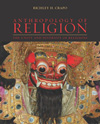
The Psychology of Religion |  |
Chapter Summary- Religion shares many similarities with other parts of expressive such as fantasy play, art, love, and mental disorders. These institutions have fuzzy boundaries and overlap in some of their characteristics.
- Feelings play an important role in religion, as they do in other parts of expressive culture. However, there is no distinctively religious emotion, that is no emotion that has only a religious significance. Any of the human emotions may be linked to religious rituals, but different religious traditions stress different emotions.
- Emile Durkheim emphasized the role of feelings such as awe, respect, and reverence for things that are sacred, set apart, and forbidden as sources of motivation to support important parts of a society's social order that are represented in religious symbolism.
- Roy Rappaport pointed out that rituals arouse strong feelings in their participants, and this reinforces socially approved attitudes about whatever the rituals symbolize. Victor Turner analyzed the interplay of sensory and ideological symbols in religious rituals as a mechanism by which strong feelings are aroused in participants and then transformed to allegiance to the object of a religion's ideological symbols.
- Bronislaw Malinowski argued that magical rituals play an important role in reducing anxiety, an idea that has been since applied to religious rituals in general. This effect is not limited to anxiety, but religious rituals may function to help people cope with any unpleasant emotion.
- Rudolph Otto emphasized the importance of feelings that are associated with concepts of the holy, that which elicits overpowering sense of dependence, awe, and dread. One form of the idea of the holy is the concept of mana, an impersonal supernatural force or sacredness that is contained in sacred things and that can be manipulated by means of religious rituals. Another is the concept of mystical union with the sacred.
- Religion also expresses feelings in the form of values. Values are higher-order feelings about what is good and bad. All religions include piety values, feelings about right and wrong behavior towards sacred things. These include taboos that forbid some behaviors that are believed to have negative supernatural consequences as well as positive injunctions for others. Some religions, most notably those in which there are differences in wealth, power, and social class, also support moral values with promises of supernatural consequencesBrewards for following them and punishments for their violation.
- Some social scientists have been influenced by Paul Tillich's view of religion as ultimate concern. Defining religion in terms of the ultimate concerns of a society or social group broadens the concept of religion in a way that highlights its similarity to other institutions which are also central to defining people's commitment to a guiding system of highest priority values. However, it also undermines the usefulness of the word religion to designate an institution that communicates a group's ultimate concerns within a supernaturalistic ideology. An approach that distinguishes between religion and other institutions that communicate ultimate concerns can still profit from noting the functional equivalent effects that such nonreligious institutions have.
- Religious symbolism is drawn from such sources as the human body and unusual features of nature. Such symbolism can carry powerful emotional significance.
- Artifacts in endless variety play a role in religion, both as markers of religious statuses and as aides to religious practice.
|
|
|